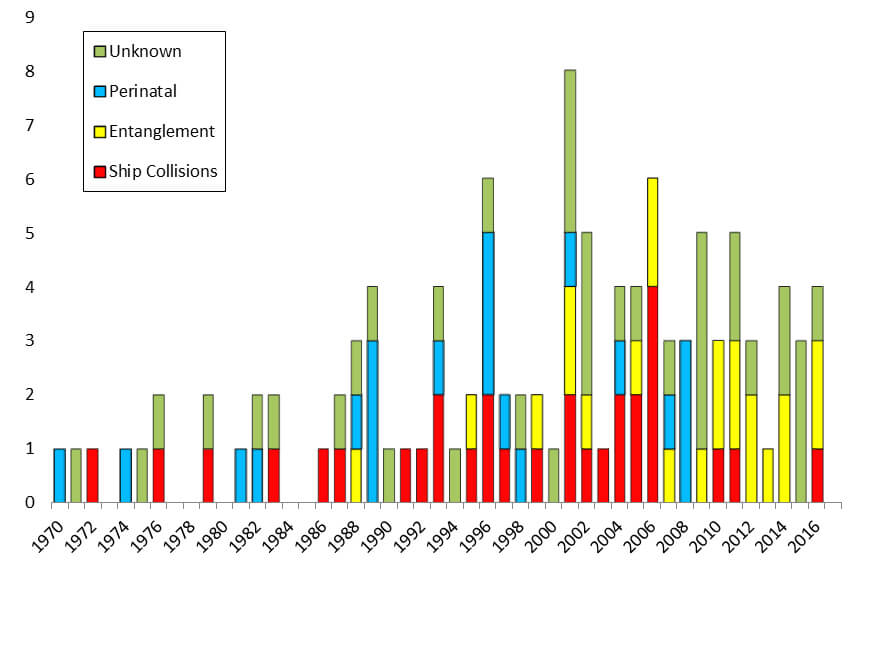Human-Caused Mortality and Injury to the North Atlantic Right Whale

Number of observed North Atlantic right whale carcasses and their causes from 1970 through October 2016. (Perinatal deaths are calves that die during the first months of life for reasons that are usually unknown.)
Since 1970, nearly half of all documented North Atlantic right whale deaths have been due to two human-related causes—ship strikes and entanglements in fishing gear. Ship strikes were the major known cause of death before the mid-2000s. After management measures were implemented between 2006 and 2008 to reduce ship strikes, deaths due to this cause have decreased significantly. However, at the same time, deaths due to entanglement have increased significantly despite management actions that began in the late 1990s. Entanglement is now the most significant known cause of right whale mortality.
Although no dead right whales were found in U.S. waters in 2015, three carcasses were found between late June and mid-July of that year in the southwestern Gulf of St. Lawrence, Canada. The causes of those deaths could not be determined. In 2016 four deaths were documented, including one attributed to a ship strike and two to entanglement. The first was a male calf hit by a ship; the carcass washed ashore on Cape Cod on May 5th. The second was a juvenile that stranded on Sable Island, Canada, September 1st with fishing gear traced to a Canadian snow crab fisherman wrapped around its flipper. The third death was that of an 11-year-old female found floating off Boothbay Harbor, Maine on September 22nd with fishing gear wrapped around its head, flippers and tail, and with line caught in its mouth. The last death was that of a whale seen floating off Mount Desert Island, Maine, also on September 22nd; unfortunately, the carcass could not be recovered for necropsy so that cause of death remains unknown. Through April of this year (2017), one carcass had been found. This was a calf killed by a ship strike found on April 13th off Barnstable, Massachusetts, Cape Cod.

Proportions of total right whale mortality each year from 1990 through 2016 that was caused by ship strikes (red) and by entanglement in fishing gear (blue)
The number of live right whales bearing signs of human interactions has continued at a high rate. In 2015, five whales were seen carrying fishing gear and four others were seen with significant new entanglement injuries but no attached gear. Also, three whales were seen with new propeller wounds from ship strikes. In 2016 11 new injury cases were reported, including six whales carrying entangling fishing gear and five others seen with significant new entanglement wounds but no attached lines. No new ship strike injuries were observed on live whales in 2016. Disentanglement teams managed to remove all or most of the gear from one of the five entangled whales seen in 2015 and from three of the six entangled animals in 2016.
